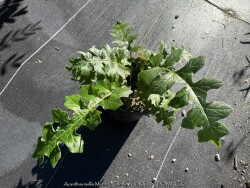

Mornings Candle Bear's Breeches / Acanthus is a clump-forming perennial that is grown as much for its attractive dark green foliage as for its architecturally bold flower spikes. It is native to the Mediterranean region. Flowers are creamy white (sometimes pinkish) and snapdragon-like. Foliage is mostly evergreen in warm winter climates, but plants lose their leaves when winter temperatures dip below 20°F. Foliage is usually persisting until mid-early December in Kansas. If low temperatures hit -10 degrees F, it may kill an un-mulched plant; protect any zone 6 perennial with thick layer of mulch. Established plants survived -16 degrees F and a week of single digit highs in February, 2021. Acanthus may be grown a potted patio plant for full to part shade. Grown in a raised pot, they are hardy to about 15-20° so you may be able to miss the first few frosts when moving them in for the winter. Before extreme cold, overwinter in a dark garage or basement with monthly watering to encourage dormancy. Alternatively, it can maintain growing in a bright window as a houseplant. Either way, they will hold up very well in the winter and maintain their attractive foliage. In spring, just cut off dead foliage and place back out in April or May with a time-release fertilizer. 'Morning's Candle' was likely the result of breeding from Acanthus spinosus and Acanthus mollis. This improved cultivar is considered an extremely adaptable and hardy selection among the Bear's breech species, combining the best characteristics of both parents.
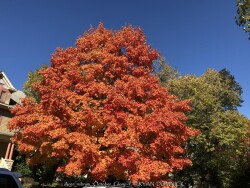

Red maple (Acer rubrum) is a large landscape tree common in Kansas and popular for its red to orange fall color and red spring flowers. While it does well in many soil types including wet compacted clays, it will struggle in an open exposed windy sites if drought stressed. Sun scald is another significant problem that can be prevented with protection or proper siting. The Red Maple has many claims to fame, including the greatest north-south range of any tree species living entirely in the eastern forests from Canada to southern Florida everglades. Its western native range is limited by lack of regular moisture, high pH soils, and intolerance to prairie wildfires. Acer rubrum 'October Glory' is noted for outstanding, reliable, bright orange to deep, reddish purple fall color - even in warmer climates. Foliage is also held on the tree later into fall than with most cultivars.
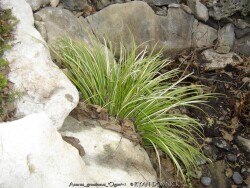

Golden Variegated Japanese Sweet Flag (Acorus gramineus 'Ogon') is a semi-evergreen marginal aquatic perennial. In constant wet conditions, it handles full-sun. It features a bright greenish-yellow grass-like tufts of narrow leaf blades. It is native to wetland areas of China, Japan, Korea, India, Thailand, Myanmar and the Philippines. In Kansas, it is very useful as a reliable rain garden plant or average garden plant in soils that do not dry out in full to part shade. Also useful on north walls and areas without tree-root competition. It cannot handle prolonged Kansas droughts or dry-shade. Foliage will flatten to the ground during brief drought then spring back up when moisture is available again. In Eastern Kansas, typically our 40 inches of rainfall is sufficient without extra water if planted in good soils. Generally however, in non-irrigated areas with poor soil, this plant will decline and allow weeds to invade. Foliage is evergreen (bright chartreuse-green) down to -5 to -10 degrees F offering valuable winter color.


Red Buckeye (Aesculus pavia) is a valuable small tree or shrub is native to the southern and eastern parts of the United States. Grow in average, medium moisture, well-drained soil in morning sun to full shade. In Kansas, growth is slow but flowers at a very young age when only a couple feet tall making it useful as a flowering shrub for the first 10-20 years. Then you can allow it to grow into a small tree. Tall ruby red flowers bloom for about a month close to redbud bloom timing and hummingbird migration back to the area. Attractive brown fruits are produced in August/September and are favored by squirrels as their first fall nut crop. Foliage is dropped rapidly making it one of the first shrubs or trees to drop its leaves sometimes as early as late September. This is rarely a problem though, as there are many other things happening in the garden in the fall.


Ajugas are extremely hardy groundcovers that quickly form a dense carpet-like mat. Unlike many perennials that are grown only for their flowers, Ajuga is prized for its attractive, evergreen colorful foliage that looks nice all year. The deepest foliage color is achieved when plants are sited in full sun and in cooler temperatures although in Kansas this may result in foliage burning in summer if not adequately watered. From mid to late spring, short deep blue flower spikes stand upright above the foliage. Do not allow foliage to be covered with leaves or mulch during winter or crown rot disease may occur wiping out large patches. Ajuga reptans 'Chocolate Chip' / 'Valfredda' is the smallest and tends to spread more slowly and stay naturally compact compared to other varieties of Ajuga, making it suitable for use as an edging, rock gardens, walking trails borders and mixed container plantings. This attractive small-scale variety has tiny carpetlike purple leaves and a dense habit.
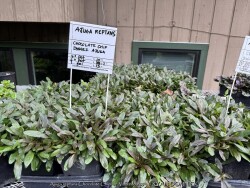

Ajugas are extremely hardy groundcovers that quickly form a dense carpet-like mat. Unlike many perennials that are grown only for their flowers, Ajuga is prized for its attractive, evergreen colorful foliage that looks nice all year. The deepest foliage color is achieved when plants are sited in full sun and in cooler temperatures although in Kansas this may result in foliage burning in summer if not adequately watered. From mid to late spring, short deep blue flower spikes stand upright above the foliage. Do not allow foliage to be covered with leaves or mulch during winter or crown rot disease may occur wiping out large patches. Ajuga reptans 'Chocolate Chip' / 'Valfredda' is the smallest and tends to spread more slowly and stay naturally compact compared to other varieties of Ajuga, making it suitable for use as an edging, rock gardens, walking trails borders and mixed container plantings. This attractive small-scale variety has tiny carpetlike purple leaves and a dense habit.


Millenium Ornamental Onion (Allium 'Millenium') is among the best of the ornamental onions. This award-winning perennial produces a compact clump of glossy green leaves. Bright rosy purple, rounded flower clusters appear on strong stems just above the foliage. Unlike spring-blooming Allium bulbs, 'Millenium' blooms in mid-summer. The attractive, shiny deep-green grassy foliage is very ornamental and lasts all season including winter interest in Kansas. Grow in just about any soil including heavy clay in full to part sun. In Eastern Kansas, typically our 40 inches of rainfall is sufficient without extra water. And as with all alliums, these are completely rabbit proof. Considered a "Once it's there, it's there forever" plant!
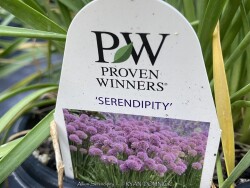

Serendipity Ornamental Onion (Allium 'Serendipity') is among the best of the ornamental onions. This award-winning perennial produces a compact clump of glossy blu-green leaves. Bright rosy purple, rounded flower clusters appear on strong stems just above the foliage. Unlike spring-blooming Allium bulbs, 'Serendipity' blooms in mid-summer. The attractive, shiny deep-green grassy foliage is very ornamental and lasts all season including winter interest in Kansas. Grow in just about any soil including heavy clay in full to part sun. In Eastern Kansas, typically our 40 inches of rainfall is sufficient without extra water. And as with all alliums, these are completely rabbit proof. Considered a "Once it's there, it's there forever" plant!
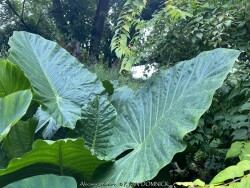

Odora Elephant Ear (Alocasia odora) is typically grown in warmer zones and features giant glossy green leaves creating quite a contrast for other colorful flowers in the garden. Most alocasia are large tropical and subtropical herbaceous perennials with a giant tubers native to areas with a summer monsoon and dry winter. Along with other tropicals and succulents in Kansas, elephant ears are usually grown as summer patio plants. Fertilize, water regularly, and place in full sun. Protect from temperatures below 28 degrees F and move into a cold garage or basement over the winter with minimal watering. Do not allow the pot with rootball to freeze solid or go below 25 degrees for more than a few hours. Allow to go dormant as needed with little care, just cut off dead foliage and place back out in April or May with a time-release fertilizer. Many plants will die back slowly and remain attractive inside for most of the winter. You may also plant these in the ground for an enormous tropical effect! It is possible to overwinter these in the ground in Kansas by placing a giant 12-18" mound of mulch over deeply planted rhizomes. New growth will usually be delayed until June but quickly regains full height. In our trial gardens in Lawrence, KS (zone 6a), three established specimens planted over 12" deep and mulched 6-12" with leaf mulch survived -17 degrees F. During the arctic blast of February, 2021, lows down to -17 degrees F on Feb 16th, 2021 were recorded. The longevity of this cold blast was also impressive: 10 days on a row with highs of 10-15 degrees F or lower, 8 nights of lows in the single digits and negatives, and 36 strait hours of 0 degrees F and mostly lower.
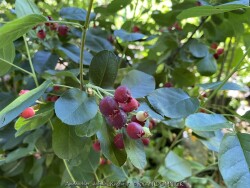

This serviceberry (Amelanchier alnifolia 'Regent') is a shrub to dwarf tree form with edible bluish-purple berry-like fruit, native to North America from Alaska across most of western Canada and in the western and north-central United States. Although it is adaptable to a variety of soil and moisture conditions, it shows some drought intolerance so go with sand plums on a drier site. The delicious fruit of this and related species are eaten fresh or prepared in puddings and pies. You need to act quick before the birds strip them clean. 'Regent' is a compact, deciduous, stoloniferous, early-flowering cultivar which typically grows only 4-6' tall. Great plant for the edible landscape!
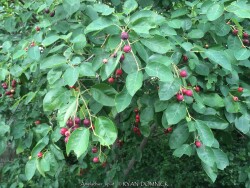

Serviceberry (Amelanchier sp.) can be a shrub or dwarf tree form with edible red to bluish-purple berry-like fruit, native to North America from Alaska across most of western Canada and in the western and north-central United States. Although it is adaptable to a variety of soil and moisture conditions, it shows some drought intolerance so go with sand plums on a drier site. The delicious fruit of this and related species are eaten fresh or prepared in puddings and pies. You need to act quick before the birds strip them clean. Great plant for the edible landscape!
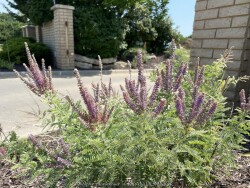

Leadplant (Amorpha canescens) is a small, deciduous perennial semi-shrub, 1-3 ft. tall, with tiny, purple flowers grouped together in colorful, terminal spikes with orange pollen. The blooming season is relatively short but the pinnately compound leaves offers lasting interest and a "Wow" factor. Leadplant can be found in many locations throughout North America but mostly in the midwest USA. Disjunct populations also exist in Texas, New Mexico and Colorado but skipping the fire-prone areas of the Great Plains. Leadplant is typically found in dry prairie pockets of land that are not overgrown, do not burn frequently, and experience minimal live-stock grazing. Leadplant grows best in drier, well-drained soil of many different textures including sandy, gravely, and rocky soils. Leadplant needs full sun for flowering and to avoid floppiness. Mainly used in Kansas landscapes in native prairie gardens, it tolerates considerable drought and alkaline limestone clay soils. It does best on a berm with great drainage or un-irrigated parking lot islands and "hell-strips". Leadplant has only one pest problem and that is rabbits! If rabbits are an issue, just put a bowl-shaped chicken wire cage around the plants for the first year. By year #2, the rapidly growing foliage will outgrow any detrimental rabbit browsing. This is definitely one of the most adapted native landscape shrubs in Kansas zone 6a with no problems with heat, cold, or drought! It's hard to imagine a native perennial garden without this plant! Butterflies will thank you!
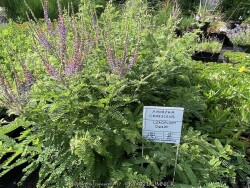

Leadplant (Amorpha canescens) is a small, deciduous perennial semi-shrub, 1-3 ft. tall, with tiny, purple flowers grouped together in colorful, terminal spikes with orange pollen. The blooming season is relatively short but the pinnately compound leaves offers lasting interest and a "Wow" factor. Leadplant can be found in many locations throughout North America but mostly in the midwest USA. Disjunct populations also exist in Texas, New Mexico and Colorado but skipping the fire-prone areas of the Great Plains. Leadplant is typically found in dry prairie pockets of land that are not overgrown, do not burn frequently, and experience minimal live-stock grazing. Leadplant grows best in drier, well-drained soil of many different textures including sandy, gravely, and rocky soils. Leadplant needs full sun for flowering and to avoid floppiness. Mainly used in Kansas landscapes in native prairie gardens, it tolerates considerable drought and alkaline limestone clay soils. It does best on a berm with great drainage or un-irrigated parking lot islands and "hell-strips". Leadplant has only one pest problem and that is rabbits! If rabbits are an issue, just put a bowl-shaped chicken wire cage around the plants for the first year. By year #2, the rapidly growing foliage will outgrow any detrimental rabbit browsing. This is definitely one of the most adapted native landscape shrubs in Kansas zone 6a with no problems with heat, cold, or drought! It's hard to imagine a native perennial garden without this plant! Butterflies will thank you!


Blue Ice Amsonia (Amsonia 'Blue Ice') is a chance seedling from A. tabernaemontana which is native to North America. It bears gorgeous deep blue buds in late spring opening to vivid a periwinkle blue for about 4-6 weeks. The bright green foliage is compact and mostly pest-free. However in some years with high humidity and extra summer rainfall, the foliage gets diseased and should be cut back early. If in good air circulation, the foliage often turns a rich shade of yellow in fall characteristic of most amsonias. In Kansas Landscapes, it is usually planted as a mass groundcover growing into a dense weed proof mass. Established plants are low maintenance and almost never need to be replaced, divided or watered.
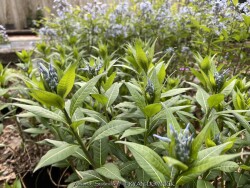

The species bluestar (Amsonia) grows up to 3 feet tall and prefers a medium to moist soil, but will tolerate a range of soils in light shade, including clay. "Once it's there, it's there forever" plant! Native to East-central U.S. in open woodlands and sunny plains. 'Storm Cloud' is and improved selection with new stems emerge near-black with leaves that are very dark green with silver veins. The stems stay dark throughout spring contrasting the light periwinkle blue, star-shaped flowers that completely cover the foliage by late spring. Some reblooming may occur for many weeks afterward. Although the main interest of this plant is in spring, it maintains a great garden presence throughout the summer and fall. Its wide, mounded habit lends itself well to be used in place of shrubs in the landscape. In some years with high humidity and extra summer rainfall, the foliage gets diseased and should be cut back early. Provide planting location with good air circulation to avoid this small problem. Compared to 'Storm Cloud', Amsonia 'Starstruck', a more compact version at 18", has wider leaves, and blooms about 1-2 weeks later in the spring. All Proven Winners® plants are legally propagated, healthy and vigorous, true to name, and tagged with color pictures and growing information.


Narrow-leaf Amsonia (Amsonia hubrichtii) is clump-forming plant that is primarily grown in cultivation for its feathery green summer foliage and golden fall color. Spring flowers are powdery blue rising on 3' stalks creating a compact dense willow-like bush. The blooming season is relatively short but the pinnately compound leaves offers lasting interest and a "Wow" factor. Rich golden fall color is long-lasting and dries remaining attractive deep into the winter. No deadheading is needed and the only maintenance is cutting the plant back each winter after the fall foliage is no longer attractive. In some years with high humidity and extra summer rainfall, the foliage gets diseased and should be cut back early. Provide planting location in full sun with good air circulation to avoid this small problem. The growth is so dense that no weeds have a chance of invading a mature stand of plants. Amsonia hubrichtii is relatively new to cultivation being discovered in Arkansas in 1942 but is hardy in zones 5-9. Combine with other summer or fall flowering plants like hardy hibiscus, crapemyrtle, or penstemon. Fine-textured foliage also combines well with dark foliage, larger leaves, and dark colored walls! Great for large-scale mass plantings needing something permanent. This is a true four-seasons long-lived perennial that belongs in almost every perennial garden. String Theory Narrow-leaf Amsonia (Amsonia 'String Theory') can be described as a compact version of the industry standard Amsonia hubrichtii. All Proven Winners® plants are legally propagated, healthy and vigorous, true to name, and tagged with color pictures and growing information.
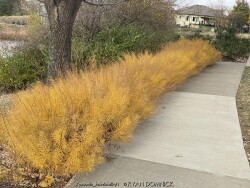

Narrow-leaf Amsonia (Amsonia hubrichtii) is clump-forming plant that is primarily grown in cultivation for its feathery green summer foliage and golden fall color. Spring flowers are powdery blue rising on 3' stalks creating a compact dense willow-like bush. The blooming season is relatively short but the pinnately compound leaves offers lasting interest and a "Wow" factor. Rich golden fall color is long-lasting and dries remaining attractive deep into the winter. No deadheading is needed and the only maintenance is cutting the plant back each winter after the fall foliage is no longer attractive. In some years with high humidity and extra summer rainfall, the foliage gets diseased and should be cut back early. Provide planting location in full sun with good air circulation to avoid this small problem. The growth is so dense that no weeds have a chance of invading a mature stand of plants. Amsonia hubrichtii is relatively new to cultivation being discovered in Arkansas in 1942 but is hardy in zones 5-9. Combine with other summer or fall flowering plants like hardy hibiscus, crapemyrtle, or penstemon. Fine-textured foliage also combines well with dark foliage, larger leaves, and dark colored walls! Great for large-scale mass plantings needing something permanent. This is a true four-seasons long-lived perennial that belongs in almost every perennial garden.
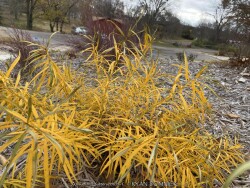

Narrow-leaf Amsonia (Amsonia hubrichtii) is clump-forming plant that is primarily grown in cultivation for its feathery green summer foliage and golden fall color. Spring flowers are powdery blue rising on 3' stalks creating a compact dense willow-like bush. The blooming season is relatively short but the pinnately compound leaves offers lasting interest and a "Wow" factor. Rich golden fall color is long-lasting and dries remaining attractive deep into the winter. No deadheading is needed and the only maintenance is cutting the plant back each winter after the fall foliage is no longer attractive. In some years with high humidity and extra summer rainfall, the foliage gets diseased and should be cut back early. Provide planting location in full sun with good air circulation to avoid this small problem. The growth is so dense that no weeds have a chance of invading a mature stand of plants. Amsonia hubrichtii is relatively new to cultivation being discovered in Arkansas in 1942 but is hardy in zones 5-9. Combine with other summer or fall flowering plants like hardy hibiscus, crapemyrtle, or penstemon. Fine-textured foliage also combines well with dark foliage, larger leaves, and dark colored walls! Great for large-scale mass plantings needing something permanent. This is a true four-seasons long-lived perennial that belongs in almost every perennial garden. Butterscotch Amsonia (Amsonia hubrichtii 'Butterscotch') is like other Amsonia in general appearance, but with improved form, reddish stems, superior rich "butterscotch" fall color, and great resistance to tip dieback. Flower color is also slightly darker blue.
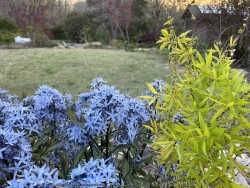

The species bluestar (Amsonia tabernaemontana) growing up to 3 feet tall and prefers a medium to moist soil, but will tolerate a range of soils in light shade, including clay. "Once it's there, it's there forever" plant! Native to East-central U.S. in open woodlands and sunny plains. Amsonia tabernaemontana 'Storm Cloud' is and improved selection with new stems emerge near-black with leaves that are very dark green with silver veins. The stems stay dark throughout spring contrasting the light periwinkle blue, star-shaped flowers that completely cover the foliage by late spring. Some reblooming may occur for many weeks afterward. Although the main interest of this plant is in spring, it maintains a great garden presence throughout the summer and fall. Its wide, mounded habit lends itself well to be used in place of shrubs in the landscape. In some years with high humidity and extra summer rainfall, the foliage gets diseased and should be cut back early. Provide planting location with good air circulation to avoid this small problem.
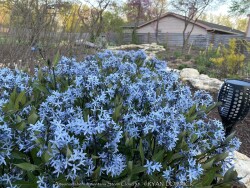

The species bluestar (Amsonia tabernaemontana) growing up to 3 feet tall and prefers a medium to moist soil, but will tolerate a range of soils in light shade, including clay. "Once it's there, it's there forever" plant! Native to East-central U.S. in open woodlands and sunny plains. Amsonia tabernaemontana 'Storm Cloud' is and improved selection with new stems emerge near-black with leaves that are very dark green with silver veins. The stems stay dark throughout spring contrasting the light periwinkle blue, star-shaped flowers that completely cover the foliage by late spring. Some reblooming may occur for many weeks afterward. Although the main interest of this plant is in spring, it maintains a great garden presence throughout the summer and fall. Its wide, mounded habit lends itself well to be used in place of shrubs in the landscape. In some years with high humidity and extra summer rainfall, the foliage gets diseased and should be cut back early. Provide planting location with good air circulation to avoid this small problem.
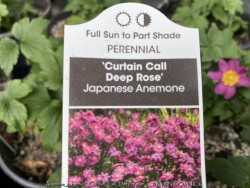

***Description for this perennial available with future update!*** Anemone 'Curtain Call Deep Rose' is also known as Curtain Call Deep Rose Japanese Anemone.
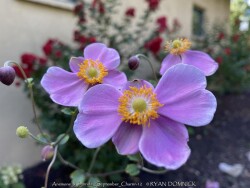

This group of herbaceous perennials are all the result of crossing two or three species, A. hupehensis, A. vitifolium, and A. tomentosa. Many cultivars now exist. Most of which flower white or pink in late summer and fall providing valuable color when many other plants have past their prime. Plants appreciate organically rich, humusy, evenly moist, well-drained soils in morning sun to part shade. Summer moisture leading upto flowering is important to avoid tattered, burnt foliage. Dark green basal growth foliage is semi-evergreen and clump-forming but plants will spread slowly. Anemone x hybrida 'September Charm' is a vigorous hybrid that typically grows to 3-4' tall and provides excellent late summer to early fall bloom from late August to October. Large silvery pink flowers with darker rose shadings and yellow center stamens appear on long, wiry-but-graceful, branching stems over an attractive foliage mound.
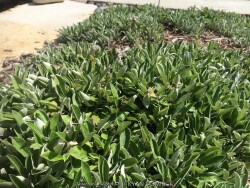

Pussytoes (Antennaria neglecta) are also known for their soft, silvery basal leaves, which spread to form a low groundcover in dry areas. Weeds have a hard time colonizing this groundcover in dry poor soil areas. Absolutely avoid planting pussytoes in moist soils or areas that have poor drainage or death will quickly occur. Native habitat across much of the Midwest and Northeast includes medium to dry black soil prairies, clay prairies, open woodlands and dry meadows. In Kansas landscapes, use as a retaining wall rock garden plant, a stepable groundcover along path, or in-between stepping stones in gravely well drained soils. Pussytoes is named for its white tufted flowers that look like tiny cat's feet. Flowers are interesting but generally best to cut before seed set as they detract from the tidy mat-like foliage. Antennaria neglecta has tiny foliage.
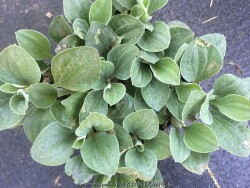

Pussytoes (Antennaria parlinii) are also known for their soft, silvery basal leaves, which spread to form a low groundcover in dry areas. Weeds have a hard time colonizing this groundcover in dry poor soil areas. Absolutely avoid planting pussytoes in moist soils or areas that have poor drainage or death will quickly occur. Native habitat across much of the Midwest and Northeast includes medium to dry black soil prairies, clay prairies, open woodlands and dry meadows. In Kansas landscapes, use as a retaining wall rock garden plant, a stepable groundcover along path, or in-between stepping stones in gravely well drained soils. Pussytoes is named for its white tufted flowers that look like tiny cat's feet. Flowers are interesting but generally best to cut before seed set as they detract from the tidy mat-like foliage. Antennaria parlinii has larger foliage and is more shade tolerant; a great plant for dry-shade.
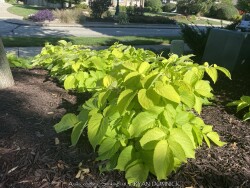

Sun King Aralia (Aralia cordata 'Sun King') is unique golden-leafed variety for the shade. The color will be brighter yellow and gold with pink leaf stalks in part sun, and more chartreuse or lime green in full shade. Tiny white flowers are insignificant and even a distraction to the gorgeous foliage. After blooming, deep purplish black, inedible berries are mildly attractive but not jaw-dropping. This unique perennial grows best in part to light shade tolerating mild drought, though if given consistent moisture it can also grow in mostly full sun. It prefers richly organic, deep loamy soil that is moist but well-drained. It typically dies back to the ground in early fall needing to be cut back then often leaving a late-season void in the garden. It re-emerges in spring to quickly form a beautiful shrub-like clump. Cold tolerance is no problem. It survived -16 degrees F and a week of single digit highs in February, 2021. No disease or pest problems other than late-season foliage decline. In Eastern Kansas, typically our 40 inches of rainfall is sufficient without extra water if planted in good soils. This is a must-have for the shade garden; combine with hostas, solomon's seal, helleborus, or ferns! Also great with shrubs such as boxwood or viburnum.
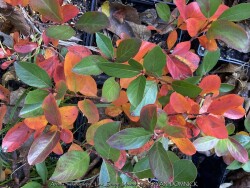

Low Scape Mound Aronia (Aronia melanocarpa 'Low Scape Mound') is a tidy little mound shaped deciduous shrub that typically grows 1-2' tall. It is native to low woods, swamps, bogs and moist thickets native from the Midwest to Canada. This 3-season shrub had appeal from spring to late fall starting with white flowers, then deep green summer foliage followed by brilliant red fall color and a few blackberries. Plant in small groups or mass plantings in small gardens. Ability to withstand wet conditions makes it suitable for growing on the margins of ponds, streams, or rain gardens. Despite 'Low Scape Mound' being touted as "drought tolerant", in the southern part of their range (Kansas), this chokeberry will decline in dry clay or alkaline soils. Watch out for deer and rabbits can devour young plants (protect with chicken wire if needed) but established plantings can generally outgrow browsing. The common name of chokeberry is in reference to the tart and bitter taste of the fruits which are edible but so astringent as to cause choking in most of those who try: no it's not poison!. Fruits are renowned for its antioxidant rich berries and high nutritional value and sometimes used to make tasty jams and jellies if enough sugar is added. Included in our "edibles" database but depends on how hungry you are! However, 'Low Scape Mound' is not grown for fruit production but rather as a compact landscape 3-season shrub tolerant of wet soils. All Proven Winners® plants are legally propagated, healthy and vigorous, true to name, and tagged with color pictures and growing information.
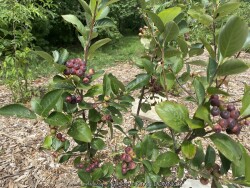

Black Chokeberry (Aronia melanocarpa), is an open, upright, spreading, somewhat rounded but leggy, suckering, deciduous shrub that typically grows 3-6' tall. It is native to low woods, swamps, bogs and moist thickets native from the Midwest to Canada. This 3-season shrub had appeal from spring to late fall starting with white flowers, then deep green summer foliage followed by brilliant red fall color and black berries. Plant in groups or mass plantings in small gardens or open woodland areas. Ability to withstand wet conditions makes it suitable for growing on the margins of ponds, streams, or rain gardens. Watch out for deer can devour young plants (protect with chicken wire if needed) but established plantings can generally outgrow deer browsing which offer free pruning to prevent legginess. The common name of chokeberry is in reference to the tart and bitter taste of the fruits which are edible but so astringent as to cause choking in most of those who try: no it's not poison!. Fruits are renowned for its antioxidant rich berries and high nutritional value and sometimes used to make tasty jams and jellies if enough sugar is added. Included in our "edibles" database but depends on how hungry you are! 'Viking' was developed in Europe for production of extra large dark purple-black fruit also used as a component of health drink juices.
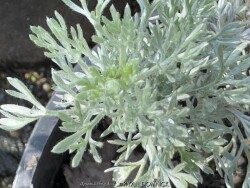

***Description for this perennial available with future update!*** Artemesia frigida is also known as Fringed Sagebrush / Prairie Sagebrush / Wormwood.
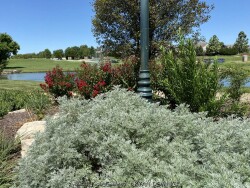

Powis Castle Artemisia (Artemisia 'Powis Castle') beautiful drought tolerant woody perennial valued for its finely dissected, aromatic, silver-gray foliage. It is evergreen down to 0 degrees F, if colder than -5degrees F, woody growth dies back too. Flowering is non-existant. As a perfect companion to vibrant flowering plants and ornamental grasses, it adds unique contrasting color and texture to waterwise landscapes. Most artemisias are best grown in poor to moderately fertile, dry to medium moisture, well-drained soils in full sun. In order to avoid occasional winter-kill in Kansas landscapes, it is advisable to plant on a south, east or west side of house or on south facing slopes or berms. Excellent soil drainage is essential for growing this plant well as poor lanky growth and root rot will occur in moist to wet soils. Tolerant of part-shade if kept dry. Cut back to 3-6" in early spring after dried winter silvery foliage stops looking attractive. New growth will emerge from the crown in mid-spring. If low temperatures hit -10 degrees F, it may kill an un-mulched plant; protect any zone 6 perennial with thick layer of mulch. General foliage decline may occur in hot and humid summer climates of the Southeast US but this is rarely a problem in Kansas or Oklahoma.
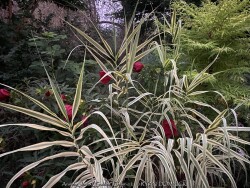

Golden Chain is a dwarf Giant Reed Grass cultivar (Arundo donax 'Golden Chain') is a perennial grass that can reach up to 8 ft. in height in Kansas in average to wet soils. Although it can be much shorter in part shade or very dry soils. The overall look is tropical like resembling corn. Flowering occurs in late summer to early fall, when plants are most easily recognized because of the large, dense flower plumes (upto 2' long) that develop at the tops of the culms. Arundo donax is native to India and spreads through rhizomes and stem nodes that come in contact with the soil. If low temperatures hit -10 degrees F, it may kill an un-mulched plant; protect any zone 6 perennial with thick layer of mulch. The non-variegated species has potential to be invasive in parts of the country but not so much in Kansas as cold winters prevent this plant from self-seeding and taking over ecosystems. Cut-back is best in the fall because canes shed leaves stalks making a mess when winter winds blow. Canes pop (but don't spark) when burning in bonfires! Make your very own firework sound effects; lots of fun with our kids! For the home garden, Golden Chain Dwarf Giant Reed Grass is much less aggressive than the species; you can mix it with other plants near the house or in rain gardens. Large clumps have been stable in our Lawrence, KS (zone 6a) display garden for over 5 years; spread is quite slow and manageable.
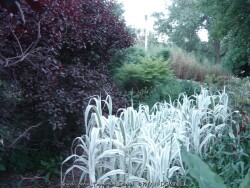

Golden Chain is a dwarf Giant Reed Grass cultivar (Arundo donax 'Golden Chain') This arundo cultivar (Arundo donax 'Peppermint Stick') is a perennial grass that can reach up to 12 ft. in height in Kansas in average to wet soils. Although it can be much shorter in full to part shade or very dry soils. The overall look is tropical like resembling giant corn. Flowering occurs in late summer to early fall, when plants are most easily recognized because of the large, dense flower plumes (upto 3' long) that develop at the tops of the culms. Arundo donax is native to India and spreads through rhizomes and stem nodes that come in contact with the soil. If low temperatures hit -10 degrees F, it may kill an un-mulched plant; protect any zone 6 perennial with thick layer of mulch. The non-variegated species has potential to be invasive in parts of the country but not so much in Kansas as cold winters prevent this plant from self-seeding and taking over ecosystems. Cut-back is best in the fall because canes shed leaves stalks making a mess when winter winds blow. Canes pop (but don't spark) when burning in bonfires! Make your very own firework sound effects; lots of fun with our kids! For the home garden, Peppermint Stick Giant Reed Grass is less aggressive than the species; you can mix it with other plants near the house or in rain gardens. Peppermint Stick maintains it's variegation unlike older variegated cultivars and does not revert or fade to green! Large clumps have been stable in our Lawrence, KS (zone 6a) display garden for over a decade; spread is quite slow and manageable.
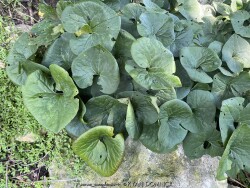

Wild Canadian Ginger (Asarum canadensis) is planted for its unusual kidney-shaped leaf pattern and bright green color. Foliage maintains well all summer provided that certain cultural conditions are met. Native to the Northern US and as far south as Missouri, it slowly colonizes forests in humusy, medium to wet well-drained soil in part shade to full shade. It can handle a little Kansas drought in in moisture-retentive soils but not dry-shade. Foliage will flatten to the ground during drought then spring back up when moisture is available again. In ideal sites, Canadian Ginger can form a dense, weed resistant groundcover in small areas. Flowers are quite attractive but usually hidden from view by the foliage. Although not related to culinary ginger (Zingiber officinale), the roots of this plant produce a scent that is reminiscent thereof. This plant is edible, however, is not normally used today for culinary purposes. Very popular in the native woodland garden in Kansas gardens and worth planting more in ideal locations.


Pink Swamp Milkweed (Asclepias incarnata) is a herbaceous perennial plant species native to North America. The foliage is bright green and upright. The blooms occurring in early to mid-summer are pink to mauve (sometimes white). After blooming, green seed pods are attractive. They finally split open in late summer releasing silver fluffy floating seeds that are whisked away in the wind. This same natural mechanism for seed dispersal is similar to that used by most other milkweed (Asclepias) species. Fall color is an attractive yellow to gold with red highlights. It is frequently grown as a bog plant needing constantly moist soil rich in organic matter. As a rain garden plant, it will thrive is a depressed area in the landscape that collects rain water from a roof during spring and summer periods of rain but then go dormant if the water hole dries out completely. This species is not shade-tolerant and will get crowded out if the rain garden becomes too dense. Pink Swamp Milkweed may also be grown in average garden soils provided extra water is supplied during droughts. It is cultivated as a garden plant for butterflies and birds at all life stages: foliage for caterpillars, nectar for butterflies and other insects, and seeds for birds. It has a latex sap containing toxic chemicals that helps it repel other insects and other herbivorous animals. In the home landscape, this species does not spread like some other milkweeds. The plant is also timid about self-seeding because seeds have to germinate in mud and quickly die if it dries out. No worries about invasiveness with this one, just count on it being a beautiful tall perennial for many years in the garden! The species is not shade-tolerant and is not a good vegetative competitor.


Orange Butterfly Milkweed (Asclepias tuberosa) is a native wildflower with bright orange flowers occurring mostly in dry open habitats and is very common in the prairies and grasslands of the Midwest and Great Plains. Common in Kansas, this beautiful native wildflower is also found from Maine to South Dakota to the desert southwest to Florida. In ideal locations established Butterfly Weeds are very showy with multiple flowering stems spreading across the two foot high plant. Mature plants also have a deep tap root that extends down a foot or more allowing them superb drought tolerance. This rugged species thrives in sunny locations, in dry sandy soil or well-drained loam. More permanent locations include limestone bluffs, rocky prairies, and Great Plains. This wildflower also colonizes readily with wind blown fluffy seeds and will grow under the mower blades sometimes completing their flowering before yearly mowing along state highways. Foliage is often green, upright and attractive. Flowering is long lasting usually 4-6 weeks with interesting seed pods developing later. These eventually open and seeds float away. Reseeding is rare in the garden as mulch will generally eliminate that possibility. In the landscape, Orange Butterfly Weed can be used in any dry soil situation including berms, hot south or west side of the house, or any other full sun area. These will grow in poor rocky, sandy or clayish soils and even rich organic soils as a beautiful flowering annual. With our average 40 inches of rain per year in eastern Kansas, extra irrigation is not recommended. When used as an annual with irrigation and rich garden soil, you can expect the amazing growth and summer flowering followed by a probable root rot in the winter. Orange Butterfly Weed can be planted in parking lot medians and other hell strips as a very durable groundcover. Orange Butterfly Weed can also thrive in an above-ground perennial planter (with appropriate potting soil) year-round surviving the winter coldness in Eastern Kansas (zone 6a/5b). In any situation, combine with any other flower colors except orange. There is quite a lot of diversity within the species so plants from different locales will have different foliage and flower shades adapted to the site. Flower color can range from almost red to pure yellow and everything in between.
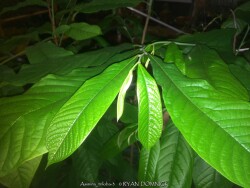

Paw Paw (Asimina triloba) is a tropical looking native understory fruit tree with large green leaves and delicious fruits. Flowers are born on old wood in the early spring and the maroon color is common of flowers meant to attract flies for pollination. Foliage is up to 12 inches long and turns a brilliant yellow in autumn for a couple weeks before falling. If cross pollination occurs, delicious fruits are produced in small clusters. The texture is custard like and taste is a mix between banana, mango, and hint of pineapple. Fruit is very fragile upon ripening and will fall to the ground and splat or be quickly devoured by animals. It is suggested that you put fruit nets around the clusters of fruit or harvest a few days earlier and allow to ripen inside. Fruit is rarely commercially available due to its fragility and short shelf-life. Cleaned fruit may be peeled frozen with seed intact: they can be picked out much easier when thawed out again Paw Paw may be eaten fresh, baked into desserts, or made into ice cream. Paw Paw is native to a large geographical area over eastern United States including Kansas. In the wild, Paw Paw grows in moist rich forest valleys in full to part shade. Best fruiting specimens can also be found on the edge of woodland or clearing in rich soil. Paw Paw tree colonies slowly spread by rhizomes and seem to occupy the forest understory sometimes for decades or centuries waiting for an opening to allow sunlight in. If a large canopy tree (such as an oak) dies or wind storm rolls through clearing a patch, new sunlight and an opening in the canopy occurs paving the way for sexual reproduction to take place (fruits) Paw Paw is somewhat tolerant of poorly drained soil's including clay but growth will be much slower. Interestingly, Paw Paws will tolerate and even need full sun when older to produce fruit. However, young saplings will quickly die in full sun from leaf burn and drought stress. If a tree is at least 4 to 6 tall and is planted in rich soil and full sun with regular irrigation, it will probably be fine. With these growing conditions, trees may grow at a median growth rate instead of slow, putting up 1 to 2 feet of new growth per year. If you have the right conditions for a Paw Paw tree, it should definitely be a part of your landscape whether you are growing for fruit production or not. There are dozens on improved cultivars available now days. In our Lawrence, KS display gardens, we are trialing several of these improved fruiting cultivars from Forrest Keeling Nursery in Missouri.


Paw Paw (Asimina triloba) is a tropical looking native understory fruit tree with large green leaves and delicious fruits. Flowers are born on old wood in the early spring and the maroon color is common of flowers meant to attract flies for pollination. Foliage is up to 12 inches long and turns a brilliant yellow in autumn for a couple weeks before falling. If cross pollination occurs, delicious fruits are produced in small clusters. The texture is custard like and taste is a mix between banana, mango, and hint of pineapple. Fruit is very fragile upon ripening and will fall to the ground and splat or be quickly devoured by animals. It is suggested that you put fruit nets around the clusters of fruit or harvest a few days earlier and allow to ripen inside. Fruit is rarely commercially available due to its fragility and short shelf-life. Cleaned fruit may be peeled frozen with seed intact: they can be picked out much easier when thawed out again Paw Paw may be eaten fresh, baked into desserts, or made into ice cream. Paw Paw is native to a large geographical area over eastern United States including Kansas. In the wild, Paw Paw grows in moist rich forest valleys in full to part shade. Best fruiting specimens can also be found on the edge of woodland or clearing in rich soil. Paw Paw tree colonies slowly spread by rhizomes and seem to occupy the forest understory sometimes for decades or centuries waiting for an opening to allow sunlight in. If a large canopy tree (such as an oak) dies or wind storm rolls through clearing a patch, new sunlight and an opening in the canopy occurs paving the way for sexual reproduction to take place (fruits) Paw Paw is somewhat tolerant of poorly drained soil's including clay but growth will be much slower. Interestingly, Paw Paws will tolerate and even need full sun when older to produce fruit. However, young saplings will quickly die in full sun from leaf burn and drought stress. If a tree is at least 4 to 6 tall and is planted in rich soil and full sun with regular irrigation, it will probably be fine. With these growing conditions, trees may grow at a median growth rate instead of slow, putting up 1 to 2 feet of new growth per year. If you have the right conditions for a Paw Paw tree, it should definitely be a part of your landscape whether you are growing for fruit production or not. There are dozens on improved cultivars available now days. In our Lawrence, KS display gardens, we are trialing several of these improved fruiting cultivars from Forrest Keeling Nursery in Missouri.
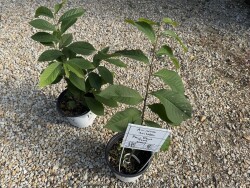

Paw Paw (Asimina triloba) is a tropical looking native understory fruit tree with large green leaves and delicious fruits. Flowers are born on old wood in the early spring and the maroon color is common of flowers meant to attract flies for pollination. Foliage is up to 12 inches long and turns a brilliant yellow in autumn for a couple weeks before falling. If cross pollination occurs, delicious fruits are produced in small clusters. The texture is custard like and taste is a mix between banana, mango, and hint of pineapple. Fruit is very fragile upon ripening and will fall to the ground and splat or be quickly devoured by animals. It is suggested that you put fruit nets around the clusters of fruit or harvest a few days earlier and allow to ripen inside. Fruit is rarely commercially available due to its fragility and short shelf-life. Cleaned fruit may be peeled frozen with seed intact: they can be picked out much easier when thawed out again Paw Paw may be eaten fresh, baked into desserts, or made into ice cream. Paw Paw is native to a large geographical area over eastern United States including Kansas. In the wild, Paw Paw grows in moist rich forest valleys in full to part shade. Best fruiting specimens can also be found on the edge of woodland or clearing in rich soil. Paw Paw tree colonies slowly spread by rhizomes and seem to occupy the forest understory sometimes for decades or centuries waiting for an opening to allow sunlight in. If a large canopy tree (such as an oak) dies or wind storm rolls through clearing a patch, new sunlight and an opening in the canopy occurs paving the way for sexual reproduction to take place (fruits) Paw Paw is somewhat tolerant of poorly drained soil's including clay but growth will be much slower. Interestingly, Paw Paws will tolerate and even need full sun when older to produce fruit. However, young saplings will quickly die in full sun from leaf burn and drought stress. If a tree is at least 4 to 6 tall and is planted in rich soil and full sun with regular irrigation, it will probably be fine. With these growing conditions, trees may grow at a median growth rate instead of slow, putting up 1 to 2 feet of new growth per year. If you have the right conditions for a Paw Paw tree, it should definitely be a part of your landscape whether you are growing for fruit production or not. There are dozens on improved cultivars available now days. In our Lawrence, KS display gardens, we are trialing several of these improved fruiting cultivars from Forrest Keeling Nursery in Missouri.
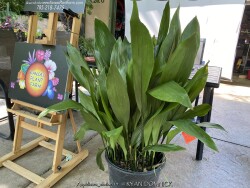

Cast-iron Plant (Aspidistra elatior) is a beautiful perennial and warmer climates for full shade. The leaves are glossy green perched on narrow stems with fat leaf blades. Unfortunately in our zone 6 Kansas climate, they cannot reliably be used as a perennial here. Most broadleaf evergreen plants are difficult to push the envelope with colder zones because evergreen leaves are more expensive to replace than for deciduous plants. (slower and requires more energy from the plant) Evergreen leaves are not intended to have to be replaced every year. In my father's zone 7a Stillwater Oklahoma garden, Cast-iron Plant can reliably be used as a perennial there but are dwarfed to about 1/2 size of normal. Anywhere south of zone 7b, count on it as a bullet-proof evergreen perennial! As a potted patio plant for full shade, they are wonderful. Grown in a raised pot, they are hardy to about 15-20° so you may be able to miss the first few frosts when moving them in for the winter. Before extreme cold (lower than 10 degrees F), they must be moved and overwintered in a dark garage or basement with monthly watering or bright window as a winter-only houseplant. Either way, they will hold up very well in the winter and maintain attractive foliage. When grown as a permanent house plant, they will last many years is grown in a bright indirect area. When Cast-iron Plant is grown as a permanent houseplant, you will need to watch for spider mites and possibly scale after a few years. Taking the whole plant outside and spraying with water a few times a year will help. Spider mites thrive and dry dusty conditions with low humidity (such as your house). Overall, Cast-iron Plants are very easy to grow hence their name. They will tolerate lower light than just about any house plant but after a few years, even this plant will decline unless given a summer growing season under a shaded tree or brighter conditions inside the house. New leaves grow about once per year and gradually the plant will need to be repotted as it is possible for them to split the container. This is a great time to divide the root system and get several new plants. This is one of our all-time favorite house plants.
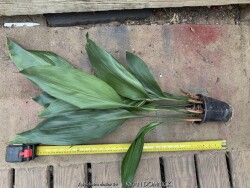

Cast-iron Plant (Aspidistra elatior) is a beautiful perennial and warmer climates for full shade. The leaves are glossy green perched on narrow stems with fat leaf blades. Unfortunately in our zone 6 Kansas climate, they cannot reliably be used as a perennial here. Most broadleaf evergreen plants are difficult to push the envelope with colder zones because evergreen leaves are more expensive to replace than for deciduous plants. (slower and requires more energy from the plant) Evergreen leaves are not intended to have to be replaced every year. In my father's zone 7a Stillwater Oklahoma garden, Cast-iron Plant can reliably be used as a perennial there but are dwarfed to about 1/2 size of normal. Anywhere south of zone 7b, count on it as a bullet-proof evergreen perennial! As a potted patio plant for full shade, they are wonderful. Grown in a raised pot, they are hardy to about 15-20° so you may be able to miss the first few frosts when moving them in for the winter. Before extreme cold (lower than 10 degrees F), they must be moved and overwintered in a dark garage or basement with monthly watering or bright window as a winter-only houseplant. Either way, they will hold up very well in the winter and maintain attractive foliage. When grown as a permanent house plant, they will last many years is grown in a bright indirect area. When Cast-iron Plant is grown as a permanent houseplant, you will need to watch for spider mites and possibly scale after a few years. Taking the whole plant outside and spraying with water a few times a year will help. Spider mites thrive and dry dusty conditions with low humidity (such as your house). Overall, Cast-iron Plants are very easy to grow hence their name. They will tolerate lower light than just about any house plant but after a few years, even this plant will decline unless given a summer growing season under a shaded tree or brighter conditions inside the house. New leaves grow about once per year and gradually the plant will need to be repotted as it is possible for them to split the container. This is a great time to divide the root system and get several new plants. This is one of our all-time favorite house plants.


The False Indigo species (Baptisia) features beautiful compact bluish green leaves arranged in groups of three. Like many members in the legume family, they are nitrogen fixing plants which means they produce their own nitrogen in the soil through a symbiotic relationship with bacteria. The flowers bloom above the foliage normally in April and May. Common baptisia flower colors include white, purple, lavender, yellow, and pink as well as uncommon colors ranging from deep purple to maroon and even coppery orange. Considered a great North American native three season plant, the foliage always emerges very attractive followed by flowers that do not need deadheading. Foliage generally lasts pretty nice through hot summers and into fall turning black with first freeze. Seed pods also turn charcoal black when ripe and have considerable ornamental interest and useful in dried flower arrangements. At some point in the fall, it can be cut down early for a clean look or left for winter interest. Baptisia generally do well in droughty clay soils in full to part sun. There is only one pest that may create problems called the Genista Broom Moth. It may occur in Kansas when weather conditions are consistently dry and over 95 degrees F. It is treatable if you act fast but if not, it only destroys the foliage late in the season and does not kill the plant. Baptisia has several enormous spreading taproots which store water and energy and can make transplanting difficult. Plantings look good as specimen or in small groups; and it's ok even preferable if they grow together and touch other plants. That helps eliminate available sunlight and discourages weeds. It is hard to picture a native plant garden or any perennial garden without Baptisia. Considered a once "it's there, it's always there" long lived plant. Baptisia 'Blue Bubbly' is a lavender-blue flowering tall variety. Its vase-like habit is topped with densely packed, blue flowers. The long, 16" flower spikes make for an extended season of bloom. This extremely long-lived perennial could be used instead of a shrub in landscape settings, with minimal care required to thrive year after year. This plant is a member of the DECADENCE® DELUXE series from Walters Gardens, Inc.
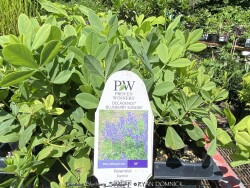

The False Indigo species (Baptisia) features beautiful compact bluish green leaves arranged in groups of three. Like many members in the legume family, they are nitrogen fixing plants which means they produce their own nitrogen in the soil through a symbiotic relationship with bacteria. The flowers bloom above the foliage normally in April and May. Common baptisia flower colors include white, purple, lavender, yellow, and pink as well as uncommon colors ranging from deep purple to maroon and even coppery orange. Considered a great North American native three season plant, the foliage always emerges very attractive followed by flowers that do not need deadheading. Foliage generally lasts pretty nice through hot summers and into fall turning black with first freeze. Seed pods also turn charcoal black when ripe and have considerable ornamental interest and useful in dried flower arrangements. At some point in the fall, it can be cut down early for a clean look or left for winter interest. Baptisia generally do well in droughty clay soils in full to part sun. There is only one pest that may create problems called the Genista Broom Moth. It may occur in Kansas when weather conditions are consistently dry and over 95 degrees F. It is treatable if you act fast but if not, it only destroys the foliage late in the season and does not kill the plant. Baptisia has several enormous spreading taproots which store water and energy and can make transplanting difficult. Plantings look good as specimen or in small groups; and it's ok even preferable if they grow together and touch other plants. That helps eliminate available sunlight and discourages weeds. It is hard to picture a native plant garden or any perennial garden without Baptisia. Considered a once "it's there, it's always there" long lived plant. Baptisia 'Blueberry Sundae' features deep indigo blue flowers much more vibrant than the original species B. australis. The deep blue-green foliage forms a more compact, upright mound to 3' tall at maturity. 'Blueberry Sundae' is a vigorous grower and the foliage looks great all summer. Ornamental seed pods extend the season of interest into fall. This plant is a member of the DECADENCE® series from Walters Gardens, Inc.
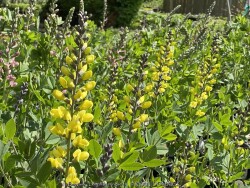

The False Indigo species (Baptisia) features beautiful compact bluish green leaves arranged in groups of three. Like many members in the legume family, they are nitrogen fixing plants which means they produce their own nitrogen in the soil through a symbiotic relationship with bacteria. The flowers bloom above the foliage normally in April and May. Common baptisia flower colors include white, purple, lavender, yellow, and pink as well as uncommon colors ranging from deep purple to maroon and even coppery orange. Considered a great North American native three season plant, the foliage always emerges very attractive followed by flowers that do not need deadheading. Foliage generally lasts pretty nice through hot summers and into fall turning black with first freeze. Seed pods also turn charcoal black when ripe and have considerable ornamental interest and useful in dried flower arrangements. At some point in the fall, it can be cut down early for a clean look or left for winter interest. Baptisia generally do well in droughty clay soils in full to part sun. There is only one pest that may create problems called the Genista Broom Moth. It may occur in Kansas when weather conditions are consistently dry and over 95 degrees F. It is treatable if you act fast but if not, it only destroys the foliage late in the season and does not kill the plant. Baptisia has several enormous spreading taproots which store water and energy and can make transplanting difficult. Plantings look good as specimen or in small groups; and it's ok even preferable if they grow together and touch other plants. That helps eliminate available sunlight and discourages weeds. It is hard to picture a native plant garden or any perennial garden without Baptisia. Considered a once "it's there, it's always there" long lived plant. Baptisia 'Lemon Meringue' is an excellent vigorous yellow flowered selection. It forms an upright, vase-shaped mound of attractive blue-green foliage topped with long, charcoal stems which carry the lemon yellow flowers in late spring to early summer. The contrast of dark stems with light flowers really pops in the landscape, delivering an excellent floral display. Ornamental seed pods extend the season of interest into fall. This extremely long-lived perennial could be used instead of a shrub in landscape settings, with minimal care required to thrive year after year. This plant is a member of the DECADENCE® series from Walters Gardens, Inc.
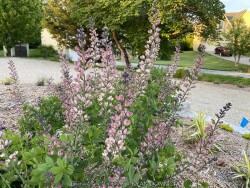

The False Indigo species (Baptisia) features beautiful compact bluish green leaves arranged in groups of three. Like many members in the legume family, they are nitrogen fixing plants which means they produce their own nitrogen in the soil through a symbiotic relationship with bacteria. The flowers bloom above the foliage normally in April and May. Common baptisia flower colors include white, purple, lavender, yellow, and pink as well as uncommon colors ranging from deep purple to maroon and even coppery orange. Considered a great North American native three season plant, the foliage always emerges very attractive followed by flowers that do not need deadheading. Foliage generally lasts pretty nice through hot summers and into fall turning black with first freeze. Seed pods also turn charcoal black when ripe and have considerable ornamental interest and useful in dried flower arrangements. At some point in the fall, it can be cut down early for a clean look or left for winter interest. Baptisia generally do well in droughty clay soils in full to part sun. There is only one pest that may create problems called the Genista Broom Moth. It may occur in Kansas when weather conditions are consistently dry and over 95 degrees F. It is treatable if you act fast but if not, it only destroys the foliage late in the season and does not kill the plant. Baptisia has several enormous spreading taproots which store water and energy and can make transplanting difficult. Plantings look good as specimen or in small groups; and it's ok even preferable if they grow together and touch other plants. That helps eliminate available sunlight and discourages weeds. It is hard to picture a native plant garden or any perennial garden without Baptisia. Considered a once "it's there, it's always there" long lived plant. Baptisia 'Pink Truffles' is an excellent vigorous pink flowered selection; quite a color break-thru for Baptisia! Clear soft pink blossoms with a pale yellow keel are produced in late spring on bright green foliage. Its compact, shorter habit makes it easy to fit into any garden. This extremely long-lived perennial could be used instead of a shrub in landscape settings, with minimal care required to thrive year after year. This plant is a member of the DECADENCE® series from Walters Gardens, Inc.


The False Indigo species (Baptisia) features beautiful compact bluish green leaves arranged in groups of three. Like many members in the legume family, they are nitrogen fixing plants which means they produce their own nitrogen in the soil through a symbiotic relationship with bacteria. The flowers bloom above the foliage normally in April and May. Common baptisia flower colors include white, purple, lavender, yellow, and pink as well as uncommon colors ranging from deep purple to maroon and even coppery orange. Considered a great North American native three season plant, the foliage always emerges very attractive followed by flowers that do not need deadheading. Foliage generally lasts pretty nice through hot summers and into fall turning black with first freeze. Seed pods also turn charcoal black when ripe and have considerable ornamental interest and useful in dried flower arrangements. At some point in the fall, it can be cut down early for a clean look or left for winter interest. Baptisia generally do well in droughty clay soils in full to part sun. There is only one pest that may create problems called the Genista Broom Moth. It may occur in Kansas when weather conditions are consistently dry and over 95 degrees F. It is treatable if you act fast but if not, it only destroys the foliage late in the season and does not kill the plant. Baptisia has several enormous spreading taproots which store water and energy and can make transplanting difficult. Plantings look good as specimen or in small groups; and it's ok even preferable if they grow together and touch other plants. That helps eliminate available sunlight and discourages weeds. It is hard to picture a native plant garden or any perennial garden without Baptisia. Considered a once "it's there, it's always there" long lived plant. Baptisia 'Plum Rosy' is an excellent vigorous pink and white flowered selection; quite a color break-thru for Baptisia! Pink blossoms age to white creating a bi-colored effect in late spring on bright green foliage. This full-size but dense habit can work like a shrub in any garden. This extremely long-lived perennial could be used instead of a shrub in landscape settings, with minimal care required to thrive year after year. This plant was introduced from Walters Gardens, Inc.
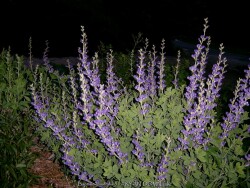

False Indigo (Baptisia australis) features beautiful compact bluish green leaves arranged in groups of three. Like many members in the legume family, they are nitrogen fixing plants which means they produce their own nitrogen in the soil through a symbiotic relationship with bacteria. The flowers bloom above the foliage normally in April and May. Common baptisia flower colors include white, purple, lavender, yellow, and pink as well as uncommon colors ranging from deep purple to maroon and even coppery orange. Considered a great North American native three season plant, the foliage always emerges very attractive followed by flowers that do not need deadheading. Foliage generally lasts pretty nice through hot summers and into fall turning black with first freeze. Seed pods also turn charcoal black when ripe and have considerable ornamental interest and useful in dried flower arrangements. At some point in the fall, it can be cut down early for a clean look or left for winter interest. Baptisia generally do well in droughty clay soils in full to part sun. There is only one pest that may create problems called the Genista Broom Moth. It may occur in Kansas when weather conditions are consistently dry and over 95 degrees F. It is treatable if you act fast but if not, it only destroys the foliage late in the season and does not kill the plant. Baptisia has several enormous spreading taproots which store water and energy and can make transplanting difficult. Plantings look good as specimen or in small groups; and it's ok even preferable if they grow together and touch other plants. That helps eliminate available sunlight and discourages weeds. It is hard to picture a native plant garden or any perennial garden without Baptisia. Considered a once "it's there, it's always there" plant.
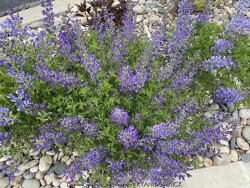

False Indigo features beautiful compact bluish green leaves arranged in groups of three. Like many members in the legume family, they are nitrogen fixing plants which means they produce their own nitrogen in the soil through a symbiotic relationship with bacteria. The flowers bloom above the foliage normally in April and May. Common baptisia flower colors include white, purple, lavender, yellow, and pink as well as uncommon colors ranging from deep purple to maroon and even coppery orange. Considered a great North American native three season plant, the foliage always emerges very attractive followed by flowers that do not need deadheading. Foliage generally lasts pretty nice through hot summers and into fall turning black with first freeze. Seed pods also turn charcoal black when ripe and have considerable ornamental interest and useful in dried flower arrangements. At some point in the fall, it can be cut down early for a clean look or left for winter interest. Baptisia generally do well in droughty clay soils in full to part sun. There is only one pest that may create problems called the Genista Broom Moth. It may occur in Kansas when weather conditions are consistently dry and over 95 degrees F. It is treatable if you act fast but if not, it only destroys the foliage late in the season and does not kill the plant. Baptisia has several enormous spreading taproots which store water and energy and can make transplanting difficult. Plantings look good as specimen or in small groups; and it's ok even preferable if they grow together and touch other plants. That helps eliminate available sunlight and discourages weeds. It is hard to picture a native plant garden or any perennial garden without Baptisia. Considered a once "it's there, it's always there" plant. Baptisia australis var. minor has a shorter and more compact stature, being native to drier Western areas compared to the species. This includes Central and Eastern Kansas, Oklahoma, Texas, and Nebraska.
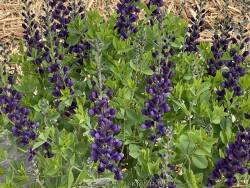

False Indigo (Baptisia) features beautiful compact bluish green leaves arranged in groups of three. Like many members in the legume family, they are nitrogen fixing plants which means they produce their own nitrogen in the soil through a symbiotic relationship with bacteria. The flowers bloom above the foliage normally in April and May. Common baptisia flower colors include white, purple, lavender, yellow, and pink as well as uncommon colors ranging from deep purple to maroon and even coppery orange. Considered a great North American native three season plant, the foliage always emerges very attractive followed by flowers that do not need deadheading. Foliage generally lasts pretty nice through hot summers and into fall turning black with first freeze. Seed pods also turn charcoal black when ripe and have considerable ornamental interest and useful in dried flower arrangements. At some point in the fall, it can be cut down early for a clean look or left for winter interest. Baptisia generally do well in droughty clay soils in full to part sun. There is only one pest that may create problems called the Genista Broom Moth. It may occur in Kansas when weather conditions are consistently dry and over 95 degrees F. It is treatable if you act fast but if not, it only destroys the foliage late in the season and does not kill the plant. Baptisia has several enormous spreading taproots which store water and energy and can make transplanting difficult. Plantings look good as specimen or in small groups; and it's ok even preferable if they grow together and touch other plants. That helps eliminate available sunlight and discourages weeds. It is hard to picture a native plant garden or any perennial garden without Baptisia. Considered a once "it's there, it's always there" plant. Many different cultivars and flower colors are available.
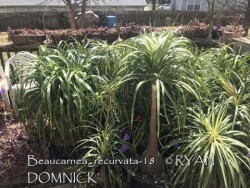

Ponytail Palm / Elephant's Foot (Beaucarnea recurvata) has a pronounced swollen caudex (trunk) and attractive green grass-like curved foliage making an excellent architectural statement. Ponytail Palm (not a true palm) is native to low deciduous forests and semi-desert areas of southeastern Mexico, Belize and Guatemala where it typically grows to as much as 30' tall. It is best used as a houseplant or summer patio plant in Kansas. Place in full sun to part sun with optional extra watering including that which comes from rainfall. Repotting may or may not be needed depending on how large you want the plant to grow; plants can continue to grow taller and tolerate extremely root-bound pots but may need wind bracing. in Potted plants are hardy to at least 25 degrees F for a short time if kept dry so you are ok if you miss the first light frost. Do not allow the pot with rootball to freeze solid though. Move into a cold garage, basement, or bright window over the winter with occasional to no watering. Larger ponytail palms can survive 6-8 months without water in the winter if allowed to have a healthy outdoor growing season. As a winter house plant, it will look presentable all winter long with just a couple waterings.(also to prevent lanky winter growth) As a permanent house plant, provide bright light and allow the soil to dry between waterings for many years (even decades) of carefree enjoyment. Potted plants grow very slow and are very low maintenance needing only old leaves trimmed once per year. Mealy bugs can be a problem with permanent indoor house plants but will go away if grown outside during the summer or never introduced in the first place. Either way, sharp blasts of hose water and/or horticultural oil spray will mostly eliminate this (only) pest problem.
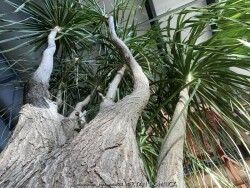

Ponytail Palm / Elephant's Foot (Beaucarnea recurvata) has a pronounced swollen caudex (trunk) and attractive green grass-like curved foliage making an excellent architectural statement. Ponytail Palm (not a true palm) is native to low deciduous forests and semi-desert areas of southeastern Mexico, Belize and Guatemala where it typically grows to as much as 30' tall. It is best used as a houseplant or summer patio plant in Kansas. Place in full sun to part sun with optional extra watering including that which comes from rainfall. Repotting may or may not be needed depending on how large you want the plant to grow; plants can continue to grow taller and tolerate extremely root-bound pots but may need wind bracing. in Potted plants are hardy to at least 25 degrees F for a short time if kept dry so you are ok if you miss the first light frost. Do not allow the pot with rootball to freeze solid though. Move into a cold garage, basement, or bright window over the winter with occasional to no watering. Larger ponytail palms can survive 6-8 months without water in the winter if allowed to have a healthy outdoor growing season. As a winter house plant, it will look presentable all winter long with just a couple waterings.(also to prevent lanky winter growth) As a permanent house plant, provide bright light and allow the soil to dry between waterings for many years (even decades) of carefree enjoyment. Potted plants grow very slow and are very low maintenance needing only old leaves trimmed once per year. Mealy bugs can be a problem with permanent indoor house plants but will go away if grown outside during the summer or never introduced in the first place. Either way, sharp blasts of hose water and/or horticultural oil spray will mostly eliminate this (only) pest problem.
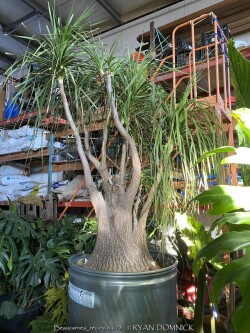

Ponytail Palm / Elephant's Foot (Beaucarnea recurvata) has a pronounced swollen caudex (trunk) and attractive green grass-like curved foliage making an excellent architectural statement. Ponytail Palm (not a true palm) is native to low deciduous forests and semi-desert areas of southeastern Mexico, Belize and Guatemala where it typically grows to as much as 30' tall. It is best used as a houseplant or summer patio plant in Kansas. Place in full sun to part sun with optional extra watering including that which comes from rainfall. Repotting may or may not be needed depending on how large you want the plant to grow; plants can continue to grow taller and tolerate extremely root-bound pots but may need wind bracing. in Potted plants are hardy to at least 25 degrees F for a short time if kept dry so you are ok if you miss the first light frost. Do not allow the pot with rootball to freeze solid though. Move into a cold garage, basement, or bright window over the winter with occasional to no watering. Larger ponytail palms can survive 6-8 months without water in the winter if allowed to have a healthy outdoor growing season. As a winter house plant, it will look presentable all winter long with just a couple waterings.(also to prevent lanky winter growth) As a permanent house plant, provide bright light and allow the soil to dry between waterings for many years (even decades) of carefree enjoyment. Potted plants grow very slow and are very low maintenance needing only old leaves trimmed once per year. Mealy bugs can be a problem with permanent indoor house plants but will go away if grown outside during the summer or never introduced in the first place. Either way, sharp blasts of hose water and/or horticultural oil spray will mostly eliminate this (only) pest problem.